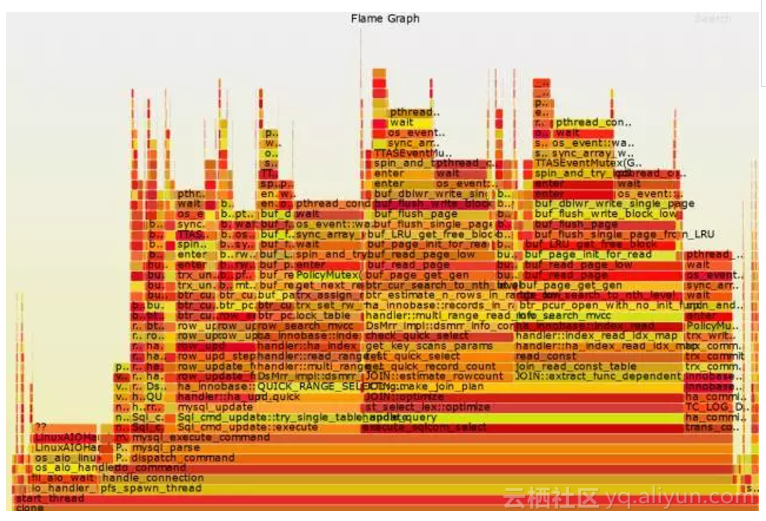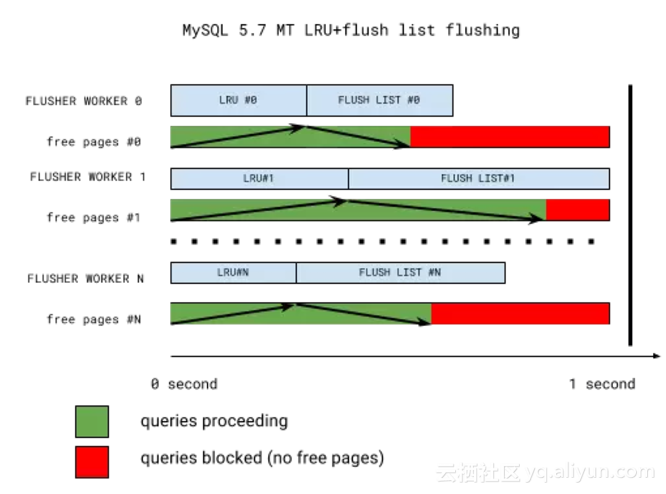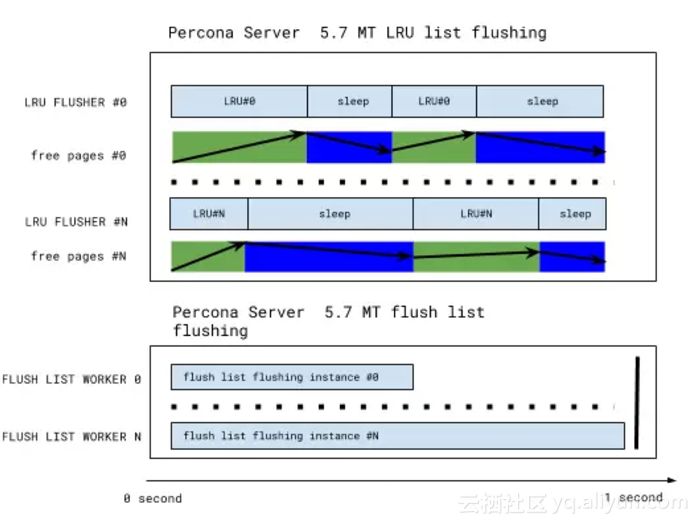In this blog post, we’ll discuss how to use multi-threaded LRU flushing to prevent bottlenecks in MySQL.
在这篇文章中,我们会讨论怎么利用多线程LRU刷新突破MySQL的瓶颈。
In the previous post, we saw that InnoDB 5.7 performs a lot of single-page LRU flushes, which in turn are serialized by the shared doublewrite buffer. Based on our 5.6 experience we have decided to attack the single-page flush issue first.
在之前的文章中(《MySQL 5.7: initial flushing analysis and why Performance Schema data is incomplete》,详见文末延伸阅读),我们看到InnoDB 5.7执行大量的单页LRU刷新,然而在共享的doublewrite buffer环节却又变成了串行模式。基于对5.6的经验判断,我们决定先挑战单页刷新这个问题。
Let’s start with describing a single-page flush. If the working set of a database instance is bigger than the available buffer pool, existing data pages will have to be evicted or flushed (and then evicted) to make room for queries reading in new pages. InnoDB tries to anticipate this by maintaining a list of free pages per buffer pool instance;
these are the pages that can be immediately used for placing the newly-read data pages. The target length of the free page list is governed by the innodb_lru_scan_depth parameter, and the cleaner threads are tasked with refilling this list by performing LRU batch flushing. If for some reason the free page demand exceeds the cleaner thread flushing capability, the server might find itself with an empty free list. In an attempt to not stall the query thread asking for a free page, it will then execute a single-page LRU flush ( buf_LRU_get_free_block calling buf_flush_single_page_from_LRU in the source code), which is performed in the context of the query thread itself.
首先,我们先描述下单页刷新的概念。如果数据库工作(活跃)数据集大于可用的buffer pool,已经存在的数据页就要面临清理或者被刷(接着清理掉),从而为查询腾出空闲页。InnoDB尝试通过维护每个buffer pool实例的空闲页列表来应对。
这些页面是可以立即用于放置新读取的数据页的。它的页面列表的长度由 innodb_lru_scan_depth参数控制,并且清理线程通过执行LRU批量刷新来填充此列表。如果由于某种原因空闲页面的请求超出了清理线程的处理能力,InnoDB需要找到一个空闲的列表。为了不阻塞查询线程请求一个空闲页,它将执行单页的LRU刷新(在buf_LRU_get_free_block中调用buf_flush_single_page_from_LRU),这是在查询线程本身的上下文中执行的。
The problem with this flushing mode is that it will iterate over the LRU list of a buffer pool instance, while holding the buffer pool mutex in InnoDB (or the finer-grained LRU list mutex in XtraDB). Thus, a server whose cleaner threads are not able to keep up with the LRU flushing demand will have further increased mutex pressure – which can further contribute to the cleaner thread troubles. Finally, once the single-page flusher finds a page to flush it might have trouble in getting a free doublewrite buffer slot (as shown previously). That suggested to us that single-page LRU flushes are never a good idea. The flame graph below demonstrates this:
这种刷新模式的问题是,它会遍历各个buffer pools instance的LRU列表,同时持有buffer pool mutex(或者XtraDB中更细粒度的LRU list mutex)。因此,当清理线程跟不上LRU刷新的需求就会进一步增加互斥量争用的压力 —— 这会给清理线程带来更多麻烦。最后,一旦单页刷新找到一个页可以进行刷新,它在获取空闲的doublewrite buffer槽(如前所述)也还是会遇到问题。这就告诉我们一个道理,单页刷新并不是一个好的解决方案。下面的火焰图说明了一切:
Note how a big part of the server run time is attributed to a flame rooted at JOIN::optimize, whose run time in turn is almost fully taken by buf_dblwr_write_single_page in two branches.
这里注意,JOIN::optimize占据很大一块时间,其运行时间几乎完全由buf_dblwr_write_single_page在两个分支中完成。
The easiest way not to avoid a single-page flush is, well, simply not to do it! Wait until a cleaner thread finally provides some free pages for the query thread to use. This is what we did in XtraDB 5.6 with the innodb_empty_free_list_algorithm server option (which has a “backoff” default). This is also present in XtraDB 5.7, and resolves the issues of increased contentions for the buffer pool (LRU list) mutex and doublewrite buffer single-page flush slots. This approach handles the the empty free page list better.
最简单的避免单页刷新的方法就是,别去做它!查询线程可以耐心等到待清理线程最终提供一些空闲的页。所以我们在XtraDB 5.6中添加了innodb_empty_free_list_algorithm选项(默认是"backoff")。这个参数也存在于XtraDB 5.7,并解决了缓冲池(LRU列表)mutex和doublewrite buffer单页刷新槽的争用问题。这种方法更好地处理了空的空闲页列表。
Even with this strategy it’s still a bad situation to be in, as it causes query stalls when page cleaner threads aren’t able to keep up with the free page demand. To understand why this happens, let’s look into a simplified scheme of InnoDB 5.7 multi-threaded LRU flushing:
即使采用了这种策略,还有一个糟糕的情景是,当page cleaner线程无法跟上空闲页面的需求,它会导致查询阻塞。为了理解为什么会这样,让我们看下InnoDB 5.7中多线程LRU刷新的简单结构图:
The key takeaway from the picture is that LRU batch flushing does not necessarily happen when it’s needed the most. All buffer pool instances have their LRU lists flushed first (for free pages), and flush lists flushed second (for checkpoint age and buffer pool dirty page percentage targets). If the flush list flush is in progress, LRU flushing will have to wait until the next iteration.
Further, all flushing is synchronized once per second-long iteration by the coordinator thread waiting for everything to complete. This one second mark may well become a thirty or more second mark if one of the workers is stalled (with the telltale sign: “InnoDB: page_cleaner: 1000ms intended loop took 49812ms”) in the server error log. So if we have a very hot buffer pool instance, everything else will have to wait for it. And it’s long been known that buffer pool instances are not used uniformly (some are hotter and some are colder).
从图中看,LRU的批量刷新不一定发生在最需要的时候。所有的buffer pool实例首先刷新LRU列表(为了释放data page),然后执行flush list刷新(达到checkpointh age和buffer pool脏页百分比条件)。如果flush list刷新正在执行,LRU刷新将不得不等到下一次刷新。
此外,所有刷新都是有协调器线程每秒同步迭代一次,直到同步完成。在error log中,如果一个工作线程停止了,可能一个1秒的标记会变成30秒或更多(比如提示:"InnoDB: page_cleaner: 1000ms intended loop took 49812ms")。所以如果我们有一个繁忙的buffer pool实例,所有都必须等待。而根据老司机的经验,缓冲池实例并不总是一成不变的(有时忙,有时闲)。
A fix should:
- Decouple the “LRU list flushing” from “flush list flushing” so that the two can happen in parallel if needed.
- Recognize that different buffer pool instances require different amounts of flushing, and remove the synchronization between the instances.
建议做如下修复:
- 将"LRU list刷新"和"flush list刷新"解耦(分离开),以便这两者在需要时可以并行执行。
- 认识到不同的缓冲池实例需要不同的刷新量,并删除实例之间的同步。
We developed a design based on the above criteria, where each buffer pool instance has its own private LRU flusher thread. That thread monitors the free list length of its instance, flushes, and sleeps until the next free list length check. The sleep time is adjusted depending on the free list length: thus a hot instance LRU flusher may not sleep at all in order to keep up with the demand, while a cold instance flusher might only wake up once per second for a short check.
综上,我们为每个buffer pool实例分配一个独立的LRU刷新线程,该线程监视实例中的空闲列表长度,刷新,然后sleep等待下一个空闲列表长度检查。休眠时间根据空闲列表长度进行调整:因此,为了跟上需求,一个繁忙的buffer pool实例可能根本不会休眠,而比较闲的buffer pool实例刷新可能每秒钟唤醒一次,进行一次短暂的检查。
The LRU flushing scheme now looks as follows:
现在,LRU刷新结构如下:
This has been implemented in the Percona Server 5.7.10-3 RC release, and this design the simplified the code as well. LRU flushing heuristics are simple, and any LRU flushing is now removed from the legacy cleaner coordinator/worker threads – enabling more efficient flush list flushing as well. LRU flusher threads are the only threads that can flush a given buffer pool instance, enabling further simplification: for example, InnoDB recovery writer threads simply disappear.
这在Percona Server 5.7.10-3 RC版本已经实现,这个设计也能简化代码。LRU的启发式刷新设计比较简单,现在任何的LRU刷新都从以前的清理coordinator/worker线程中移除——实现了更有效的flush list刷新。LRU刷新线程是可以刷新给定buffer pool的唯一线程,还可以进一步简化:比如,取消InnoDB 恢复写入线程。
Are we done then? No. With the single-page flushes and single-page flush doublewrite bottleneck gone, we hit the doublewrite buffer again. We’ll cover that in the next post.
原文发布时间为:2017-10-31
本文作者:天一阁@知数堂
本文来自云栖社区合作伙伴“老叶茶馆”,了解相关信息可以关注“老叶茶馆”微信公众号





